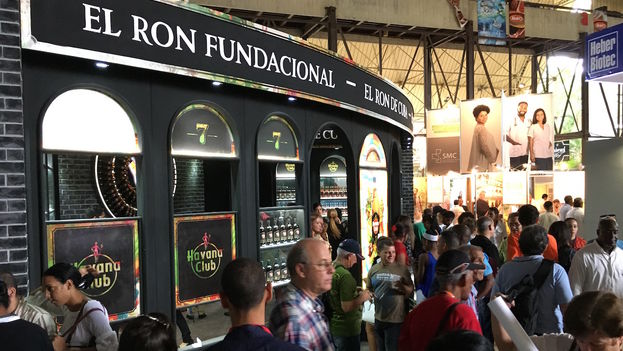
![]() 14ymedio, Reinaldo Escobar, Havana, 7 November 2016 – The appearance of unusual proposals such as ostrich farming, the production of quail eggs, or the tanning of exotic hides, along with the timid introduction of a banking sector, are some of the most significant novelties in the Portfolio of Opportunities for Foreign Investment launched during the recently concluded International Fair of Havana.
14ymedio, Reinaldo Escobar, Havana, 7 November 2016 – The appearance of unusual proposals such as ostrich farming, the production of quail eggs, or the tanning of exotic hides, along with the timid introduction of a banking sector, are some of the most significant novelties in the Portfolio of Opportunities for Foreign Investment launched during the recently concluded International Fair of Havana.
The illusions generated in 2014, with Cuba’s new openness to foreign capital, have lost strength along the way. The third edition of the portfolio targeted to international business is evidence of this disengagement. The document repeats proposals that didn’t find any takers and adds timid offerings that have yet to overcome mistrust.
Investors have not “fallen all over themselves” before the pieces of Cuban cake. In part, because there is no easing of the concerns about the dual monetary system, but, fundamentally, because there is no easing in the short term to make the country an attractive and secure place to set up a business.
The current Portfolio offers 395 projects distributed in 14 areas of the economy. Compared with the previous year, it presents two more sectors: sugar and hydraulics. In all, there are 69 additional options from 2015, and some 149 more than in the document published two years ago.
However, as often happens, the numbers don’t tell us everything in this case. Only three sectors, sugar, food production and tourism, are responsible for the “new opportunities,” while construction, industry and mining show a decline.
In the area of health, the three projects from the previous year remain almost unchanged, with the difference that the investment for the International Sports Medicine Clinic is no longer estimated at 11 million dollars but at 18.3 million. The reason for the cost increase is not clear.
Something similar happens with the creation of audiovisuals, which appeared in the portfolio for the first time in 2015. Among the offerings still included, which no one seemed to take up, are projects for a national cable television system, an initiative to improve teaching in computer science and audiovisual media, along with the creation of a forum for the production of high definition materials.
The portfolio is not, as many believe, an inventory of what is up for auction on the island, but a list of what has fallen to pieces or that will fail to exist if it doesn’t receive, quickly, the fresh air of foreign capital. Its pages describe the nation’s economic holes and the amounts fixed, along with the conditions imposed, which resound as the request of an arrogant and disturbed beggar.
The Mariel Special Development Zone (ZEDM), where only last week the “first stones” of two industries were laid, maintained its privileged position at the beginning of the document. Some of the projects of that economic enclave are repeats of the offerings from two years ago, without the wave of enthusiasm initially predicted for the desolate site.
The longed-for “plant with clean technology for the assembly and production of a minimum level of light vehicles,” is back on stage, although this time the offer differs from the two previous editions, when it was offered as a joint-venture project. Now the government has chosen to give way and accept that it would be established as an enterprise with wholly foreign capital.
The same change has happened to the project for a plant “with clean and leading edge” technology for producing dinnerware, glasses and cups for the hotel industry. Currently these products are almost entirely imported and supply instabilities plague the tourist sector.
The stagnation in the ZEDM has also affected the mythical plant for glass containers for beverages, medicines and preserved food, with a cost of 70 million dollars. The operation of this industry depends on everything from the production of pharmaceuticals to the manufacture of soft drinks, beer and compotes for children.
In the rest of the country other projects are repeated year after year, among them a proposal for the technological modernization of a slaughter line for 3,000 chickens per hour, as a joint venture; one for rice production in the province of Artemisa; and others for peanut and coffee processing.
Sugar, which broke into the pages of the portfolio in 2014 with the proposal to improve corporate governance in four sugar mills, just reappeared a year later through an overview from the state sugar company Azcuba. After the successive failures of past harvests, it is now proposing the added processing of cane derivatives.
The telecommunications, information technology and communications sector hovers in the portfolio, but without detailing specific projects. The only information that is presented is that “it excludes the form of wholly foreign-owned enterprises in this sector,” a way of maintaining state control over the transfer of information.
In the last pages of the punctilious document the banking and financial sector is mentioned for the first time, but only to present the facilities investors can count on. The text warns, however, that “investment in the capital of 100 percent Cuban financial institutions is excluded, along with the establishment of branches of foreign banks.”
The new portfolio opens an era of expectations. Optimists are confident that the tinkered-with projects will generate some enthusiasm among investors, but they forget that no gesture is made more cautiously than putting one’s hand in one’s pocket. There is no one more difficult to trust with one’s capital than those who have disdained wealth and systematically assaulted the patrimony of foreign owners.
